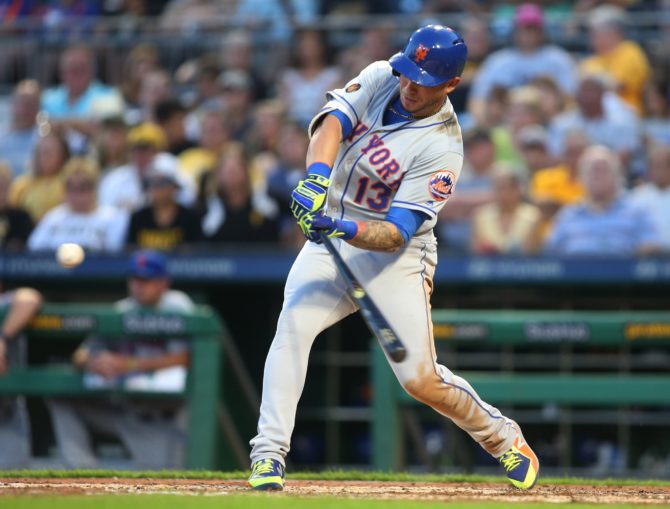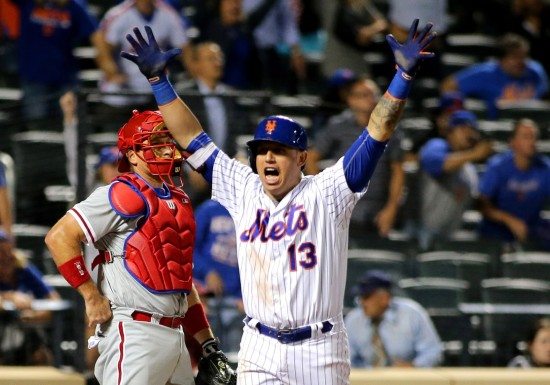
While the New York Mets’ 2016 season ended prematurely in the National League Wild-Card play-in game, the ride over the regular season’s final six weeks just to get there was a ton of fun.
Before finishing 87-75, which led to hosting Madison Bumgarner and the San Francisco Giants at Citi Field, they looked pretty dead in the water at the end of play on August 19th with a 60-62 record. Sure, they were only 5.5 games behind the second wild-card spot, but New York had to get hot in a big way to make this dream even a remote reality.
As we all know, that’s exactly what they did.
Manager Terry Collins watched his position players lead the league with 8.7 fWAR from August 20th through the end of the season. This group also slugged 60 home runs, which was second in baseball to only the Baltimore Orioles (65), and their cumulative 113 wRC+ was also second best (the Detroit Tigers were first with a 118 mark). This was just about a complete 180-degree turn from the start of the season through August 19th — the Mets were among the top 10 with 158 homers, but their collective 14.6 fWAR was ranked 15th, while a team wRC+ of 94 was firmly in the bottom third of baseball.
The start of New York’s late-season surge toward a wild-card berth coincided with Yoenis Cespedes and Asdrubal Cabrera both returning from the Injured List. Cespedes did his usual amount of mashing, but it was Cabby who went above and beyond down the stretch. I mean, while none of us forgets the walk-off homer and bat flip, he was doing something every night for the Mets when they needed it the most.
Compared to the Rest of Baseball
Cabrera either led or was tied for the team lead in just about every important offensive category. So, with a .347/.410/.646 line, 10 homers, 29 RBI, and a 184 wRC+ — all of which led to 2.4 fWAR — I was curious as to how he measured against the rest of baseball during this six-week span.
As it turns out, the comparisons were favorable.
Among qualified hitters, Cabrera’s 2.4 fWAR was second in baseball, with only some guy named Mike Trout (2.6) finishing ahead of him. He was also among the top five in wRC+ and OPS (1.056), while those 29 RBI he collected were among the top 15.
Curtis Granderson actually wasn’t too far behind his teammate when looking at his own wRC+ (165) and OPS (1.002), so when we combine Grandy’s performance with Cabby and Yo, the overall offensive lift the Mets saw wasn’t a surprise in the slightest.

Compared His Own Performance
When looking at Cabrera’s season-long numbers, the 2016 campaign was certainly one of his best. His cumulative 3.6 fWAR and 23 homers were both the second-best numbers of his career to 2011, when he accumulated 3.7 fWAR and slugged 25 dingers for the Cleveland Indians. If we want to single out the above six-week period yet again, the 2.4 fWAR he posted ended up being higher than six different full seasons and was within an earshot of three others.
Considering the fact that he’s been in the big leagues for parts of 13 seasons now, this stretch in 2016 appears to be one of those once-in-a-career-hot-as-the-face-of-the-sun periods of time.
However, it wasn’t that he was necessarily having a bad year up to that point because he seemed to come up big in crucial situations. Regardless, the numbers effectively showed his performance as being meh. Through his first 407 plate appearances (up to August 19th), he slashed .255/.307/.408 with 13 home runs, 33 RBI, and a 94 wRC+.
Before he nearly doubled a number of his season-long counting stats, his wRC+ put him in the company of guys like Cheslor Cuthbert, Addison Russell, and Denard Span. That’s quite a different group than Mike Trout, I’d say.
The obvious question to ask here is, what the heck happened? One thing that jumps out is a dramatic rise in BABIP, going from .291 to .357 between these periods of time. And with just a five-percentage-point increase in hard-hit rate (35.2% to 40.2%), it’d be easy to point and say it was good luck. This isn’t to say good fortune wasn’t on Cabby’s side, but his batted-ball profile shows he earned every bit of this hot streak:

All of the classic signs of elite production lie in these numbers, most notably the 10-percentage-point drop in ground balls and an almost equal drop in infield flies. And while his hard-hit rate didn’t have as dramatic of a jump one would assume, he cut down significantly on soft contact.
It would’ve been more than cool if the Mets’ entrance into the 2016 postseason lasted for more than one game. But if any of us were told they’d even be participating in October baseball back on August 19th, we all would’ve thought someone was crazy.
Thankfully, they weren’t, and Cabrera’s incredible streak of elite production was a huge reason why New York even got there.
















